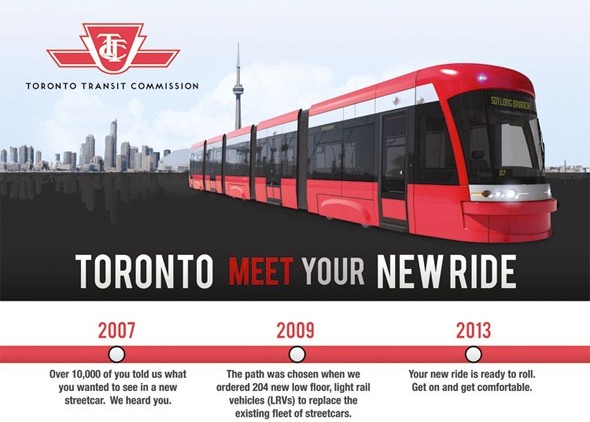Transit City in Toronto was the long term public transportaton plan proposed by former Mayor David Miller’s regime to solve the city’s transit problems. It called for up to seven lines of light rail transit (LRT), which would mostly travel above surface on city roads. The proposal moved away from subways (or heavy rail) expansions. However, the last mayoral race shocked many as the right-leaning Rob Ford was elected Mayor and he scrapped the plan and vowed to replace it with subway trains. Since this time, it has become a polarizing Left vs. Right issue in the city with the Left supporting Transit City and the Right supporting subways.
As far as I’m concerned the Transit City plan being axed is a good thing for all the citizens of Toronto. The Transit City LRT plan was a half baked idea, chosen not because it was the best plan, but because it was cheaper and faster to build than subways and easier to sell politically. The plan that makes the most sense in the long term for Toronto would be to have the underground subway system as the backbone of transit. This would be the best plan for passengers, best plan for the long term challenge of traffic and cost wise the best investment.
Streetcars on Steroids
The LRT plan costs less per KM to build. However, when compared to subways they carry less passengers, travel slower and have more frequent stops (distance wise) as stations will be less spaced out than subway stations. Also, LRTs have a life time of between 25-50 years and are less reliable compared to subways, which are designed to last 75-100 years, making the investment in subways nearly the same cost – if not less costly – in the long term while providing truly rapid transit.
LRTs also would not be the best choice for passengers as transit riders would have to stand out waiting in the open for the LRT vehicles in the rain and harsh Canadian winter weather. Most passengers would be forced to make multiple transfers between different LRT lines to get to their destination as there would be numerous LRT lines crisscrossing the city. Also, because the LRTs would replace buses on some routes, they will run with less frequent stops compared to buses making commuters walk longer to get to subway stations or their destination. All of this simply means Transit City would not get passengers to their destination the fastest way possible, as the LRTs would be nothing more than glorified streetcars.
Make Love, not War on Cars
It’s hard to understand why the LRT plan is tooted the as more environmentally friendly, “progressive” plan. The LRT vehicles would be designed to run in the centre of some of the busiest roads in Toronto, with regular motor vehicles getting left turns restricted and forcing them to go to the next signalled intersection to make a U-turn to get their to their destination. This would further clog the already congested roads, increasing idling time for motor vehicles and carbon emissions. This makes little sense, other than to those who believe that it is better to force motor vehicles to be gridlocked for hours. With LRT tracks and bike lanes getting in the way in a “war on cars” scenario, the hope is it will force people to stop driving polluting cars; a so called ‘progressive’ vision to make Toronto a more environmentally friendly city.
The Bottom Line
Subways are the way to solving the challenges for Toronto in the long term as subways are more reliable, move people faster and last longer than LRTs. With a truly reliable and fast subway system as the backbone of transit in Toronto, more people would be open to ditching the car in favour of transit.
– Sudan Ponnuchamy

 Sudan Ponnuchamy
Sudan Ponnuchamy






